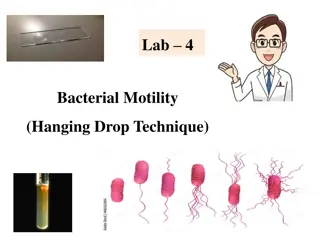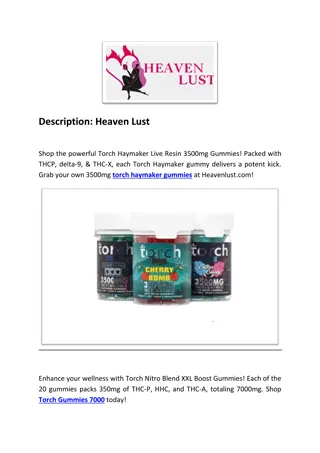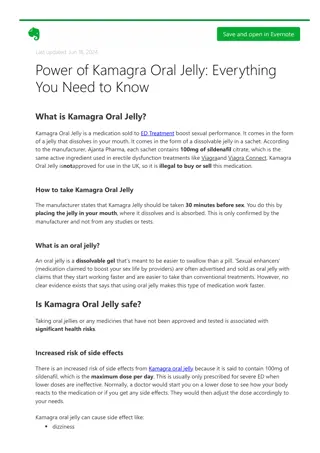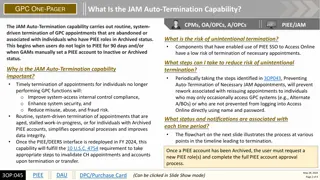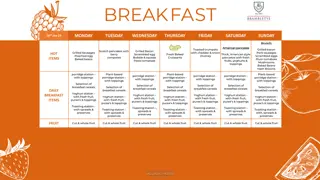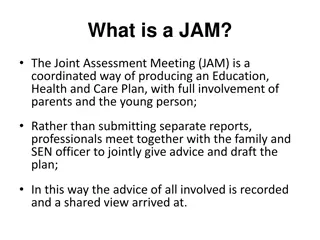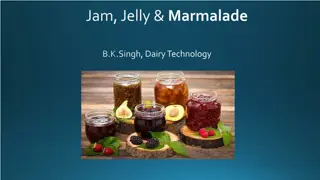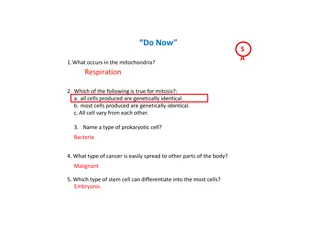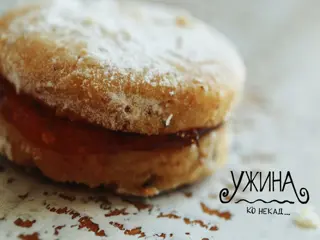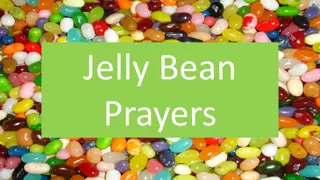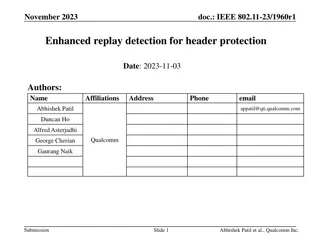
Fruit Processing: Jams, Jellies, and Marmalades Overview
Explore the world of fruit processing with a detailed look at jams, jellies, and marmalades. Learn about India's role as a major producer, the process of making jams at home, technological flow sheets for jam production, common problems in jam making, and more.
Download Presentation

Please find below an Image/Link to download the presentation.
The content on the website is provided AS IS for your information and personal use only. It may not be sold, licensed, or shared on other websites without obtaining consent from the author. If you encounter any issues during the download, it is possible that the publisher has removed the file from their server.
You are allowed to download the files provided on this website for personal or commercial use, subject to the condition that they are used lawfully. All files are the property of their respective owners.
The content on the website is provided AS IS for your information and personal use only. It may not be sold, licensed, or shared on other websites without obtaining consent from the author.
E N D
Presentation Transcript
JAM, JELLY AND MARMALADE JAM, JELLY AND MARMALADE Jai Singh Deptt. Of Food Technology CBL Govt. Polytechnic, Bhiwani
INTRODUCTION INTRODUCTION India is the second largest producer of fruit and vegetables in the world. Total area under fruit and vegetable cultivation is estimated at 12 million hectares, which is 7% of total cropped area in the country. The commercial processing of fruit & vegetables is approximately 2.0%. India exported vegetables worth Rs. 5240 million in 1997-98. During 2015-16, India exported fruits and vegetables worth Rs. 8,391.41 crores which comprised of fruits worth Rs. 3,524.50 crores and vegetables worth Rs. 4,866.91 crores. processed fruits and Area (1000ha) Production (1000 tonne) 88819 168300 Productivity (Tonne/ha) Fruits vegetables 6358 9541 13.97 17.64 As per the latest estimates, by (CIPHET), Ludhiana, the wastage of fresh horticultural produce is upto 18 per cent due to poor postharvest management practices. perishable horticultural produce is processed to value added products. Hardly 2 per cent of 2
J JA AM M Jam is a product made by boiling fruit pulp with sufficient sugar to a reasonably thick consistency, firm enough to hold the fruit tissues in position . . Apple, pear, sapota (chiku),apricot, loquat, peach, papaya, karonda, carrot, plum, straw- berry, raspberry, mango, tomato, grapes and muskmelon are used for preparation of jams. It can be prepared from one kind of fruit or from two or more kinds . Jam contains 0.5-0.6 per cent acid and sugar should not be more than 40 percent and TSS 68%. 3
IN THE HOME IT CAN BE PREPARED BY USING THE RECIPES AS: Fruit/ vegetable for 1 kg pulp Sugar (kg) Citric acid (gm) Water (ml) Aonla .75 - 150 Apple .75 2.0 100 Apricot .60 1.0 100 Carrot .75 2.5 200 Grapes .70 1.0 50 Guava .75 2.5 150 Karonda .80 - 100 4
TECHNOLOGICAL TECHNOLOGICAL FLOW FLOW SHEET SHEET FOR FOR PROCESSING PROCESSING OF OFJAM JAM Ripe firm fruits Washing Peeling Pulping Addition of sugar 5
Boiling Addition of citric acid Judging of end point by further cooking up to 105 degree Celsius or 68% TSS or by sheet test Filling hot into bottles Cooling Waxing Capping Storage 6
PROBLEMS IN JAM PRODUCTION : Crystallization I. II. Sticky or gummy jam III. Premature setting IV. Surface graining and shrinkage V. Microbial spoilage 7
JELLY A jelly is a semi-solid product prepared by boiling a clear, strained solution of pectin containing fruit extract, free from pulp, after the addition of sugar and acid. A perfect jelly should be transparent, well-set, but not too stiff, and should have the original flavour of the fruit. It should be of attractive colour and keep its shape when removed from themould. It should be firm enough to retain a sharp edge but tender enough to quiver when pressed. It should not be gummy, sticky or syrupy or have crystallized sugar. The product should be free from dullness, with little or no syneresis (weeping), and neither tough nor rubbery and should have TSS 65% , 0.5 - 0.75% acid and 45% of fruitjuice. 8
IMPORTANT IMPORTANT CONSIDERATIONS CONSIDERATIONS IN IN JELLY JELLYMAKING MAKING Pectin Alcohol test Jelmeter test A. Acid Sugar Judging of end point Sheet or flake test Drop test iii) Temperature test A. I. Alcohol test II. B. Sheet test Temperature test C. i) ii) Drop test 10
TECHNOLOGICAL TECHNOLOGICAL FLOW FLOW SHEET SHEET FOR FOR PROCESSING OF PROCESSING OFJELLY JELLY Fruit (firm not over ripe) Washing Cutting into thin slices Boiling with water ( for about 20-30 min ) Addition of citric acid during boiling( 2gm per kg of fruit ) Straining of extract Pectin test ( for addition ofsugar ) 11
Addition of sugar Boiling Judging of endpoint Removal of scum or foam ( 1 teaspoonful edibleoil is added for 45 kg sugar) Colour and remainingcitric acid added ) Filling hot into bottles Waxing Capping Storage atambient temperature 12
PROBLEMS IN JELLY MAKING 1. Formation of crystals : 2. Failure to set : (i) Addition of too much sugar (ii) Lack of acid or pectin (iii) Cooking below the end-point (iv) Cooking beyond the end-point (v) Prolonged cooking (i) Use of non-clarified juice or extract (ii) Use of immature fruits (iii) Over-cooking (iv) Over-cooling (v) Non-removal of scum (vi) Faulty pouring (vii) Premature gelation (i) Excess of acid (ii) Insufficient pectin (iii) Premature gelation (iv) Fermentation 3. Cloudy or foggy jellies : 4. Syneresis or weeping of jelly : 13
MARMALADE This is a citrus fruit product prepared by cooking fruit pulp or extract with sufficient amount of sugar and using shreds of peel as suspended material. Marmalades are classified into : Jelly marmalade Jam marmalade 1. 2. The practically the same as that for jelly marmalade. In this case the pectin extract of fruit is not clarified and the whole pulp is used. Sugar is added according to the weight of fruit, generally in the proportion of 1:1. The pulp-sugar mixture is cooked till the TSS content reaches 65 per cent. method of preparation for jam marmalade is 14
PROBLEMS IN MARMALADE PROBLEMS IN MARMALADE MAKING MAKING Browning during storage is very common which can be prevented by addition of 0.09 g of KMS per kg of marmalade containers. KMS dissolved in a small quantity of water is added to the marmalade while it is cooling. KMS also eliminates the possibility of spoilage due to moulds. and not using tin 15
T TE EC CH HN NO OL LOG MARMALADE MARMALADE OGI IC CA AL L F FL LO OW W S SH HE EE ET T F FO OR R P PR RO OC CES ESS SING ING OF OF Ripe fruits Washing Peeling outer yellow portion ( flavedo ) Cutting yellow portion into fine shreds ( 1.9-2.5 cm long and .08 - .12 cm thick) Boiling Straining theextract Testing for pectin content ( alcohol test) Addition of sugar 16
Cooking to 103 to 105 degree Celsius Addition of prepared shreds Boling till jellying point Testing for end point Cooling ( 82-88 degree Celsius) flavouring Filling in sterilized bottles Sealing Storage at ambient temperature 17



